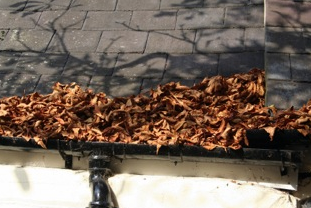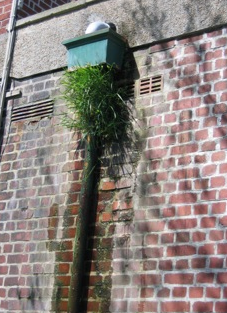Protecting our buildings and our heritage – careful maintenance makes good sense
 “It can prove to be an extremely costly over sight to neglect checking and regularly maintaining a building’s guttering system” warns Rainclear Systems’ Managing Director Geraint Jones. “After a property’s roof, a rainwater disposal system is one of the most critical features of a building which can both influence its unique character and ensure its care and preservation.
“It can prove to be an extremely costly over sight to neglect checking and regularly maintaining a building’s guttering system” warns Rainclear Systems’ Managing Director Geraint Jones. “After a property’s roof, a rainwater disposal system is one of the most critical features of a building which can both influence its unique character and ensure its care and preservation.
It’s a feature which can be easily overlooked, but at a building’s peril – especially an historic or listed building.” Designed to remove water from a building, leaking or inadequate guttering, hoppers and downpipes can lead to damaging internal and external conditions such as damp, flooding or dry rot – all potentially destructive and expensive to rectify.
In a modern building the rainwater system will be chosen from a range of materials and for a variety of reasons from appearance, to cost, to sustainability. In an older building it will usually be made from cast iron. Cast iron rainwater goods were first introduced in the mid 13th Century and grew in popularity in the 19th century as they became mass produced and more readily available. Cast iron is a substantial, strong and versatile material. Handsome in appearance, as well as a robust choice, a cast iron system is often a key part of a building's aesthetic make-up as well as a hugely practical feature that will help a building stand the tests of time. It is essential that these systems are cared for, if they are, they will look after the buildings they are designed to protect.
Geraint Jones explains “It’s not unreasonable to say that with sensible maintenance you can expect a cast iron rainwater system to last a hundred years! As with all gutter systems, they require regular checking – at least twice a year – removing any debris or vegetation from drainage channels, hopper heads and flat roofs. The older the system is, the more important it is to be vigilant. You also need to check the joints and paint carefully – if these become damaged the metal below will eventually rust and a damaged system will lead to the deterioration of the fabric of a building, something to avoid at all costs.”
 This year The Society for the Protection of Ancient Buildings’ SPAB’s) ‘National Maintenance Week’ ends on 28th November with their thirteenth ‘National Gutters Day’ helping to raise awareness of the importance of our buildings’ guttering and encouraging property owners to inspect them and avoid the problems caused by a damaged or inadequate system. This year’s spokesman for the campaign, Loyd Grossman said “As Chairman of the Churches Conservation Trust, I’m already very familiar with the maintenance challenges faced by significant, historic buildings which don’t conform to a standard pattern. Careful, planned and regular maintenance is vital to ensure that they have a future as well as a past. But that message is equally applicable to buildings of all types and all ages.
This year The Society for the Protection of Ancient Buildings’ SPAB’s) ‘National Maintenance Week’ ends on 28th November with their thirteenth ‘National Gutters Day’ helping to raise awareness of the importance of our buildings’ guttering and encouraging property owners to inspect them and avoid the problems caused by a damaged or inadequate system. This year’s spokesman for the campaign, Loyd Grossman said “As Chairman of the Churches Conservation Trust, I’m already very familiar with the maintenance challenges faced by significant, historic buildings which don’t conform to a standard pattern. Careful, planned and regular maintenance is vital to ensure that they have a future as well as a past. But that message is equally applicable to buildings of all types and all ages.
Nearly 140 years ago SPAB’s founder William Morris told us to ‘stave off decay by daily care, to prop a perilous wall or mend a leaky roof’ and that’s still sound, practical advice. Good maintenance is simply good common sense. It’s economic sense too. Faulty gutters and blocked drains don't mend themselves - the longer you ignore a problem the more costly and difficult it becomes to put it right, and that’s true if the building you care for is a medieval church in a village or an apartment in a town or city.”
Included in SPAB’s ’10 Minute Home MOT’ tips are the following reminders:
1. Check gutters
- are they leaking at joints?
- do they overflow?
- are they catching water from the roof or is it running down the wall?
Looking on a rainy day is by far the best
2. Behind the gutters are the soffit and fascias and at the end of the roof quite often there are barge boards. If they are timber check if they need painting as bare wood rots quickly
3. Are your rainwater pipes working?
- they can be cracked
- not fixed securely
- or just blocked with things like leaves, twigs, tennis balls and even dead birds!
Green algae or vegetation on adjacent walls is a common sign of a problem
If a cast iron system does become damaged and needs renovating or replacing, it is often obligatory and always recommended that it be replaced in the same material. The good news is that some modern companies specialising in metal rainwater systems, such as Rainclear Systems, stock a wide range of cast iron profiles and work closely with the few remaining UK foundries to create and supply quality and often bespoke systems or parts at good value.
Geraint is proud of how his team supports people requiring tailored rainwater products. “We are frequently contacted by a contractor, builder or architect with an historical renovation project on their hands and are always delighted to help them with their particular requirements however challenging. Although we hold the largest stock of cast iron rainwater products in the UK, sometimes finding an exact replacement profile or hopper head for example can be tricky.
Our team will work closely with anyone needing something special to ensure they get the piece or system that is ideal for the property – they are often surprised at what we can achieve!”
Protecting our older properties through the prudent maintenance or refurbishment of something as basic as a rainwater system really can avoid serious problems and costs and help maintain our landscape of unique and inspiring historic buildings.
• To find out more about what Rainclear have to offer in the sector visit www.rainclear.co.uk















